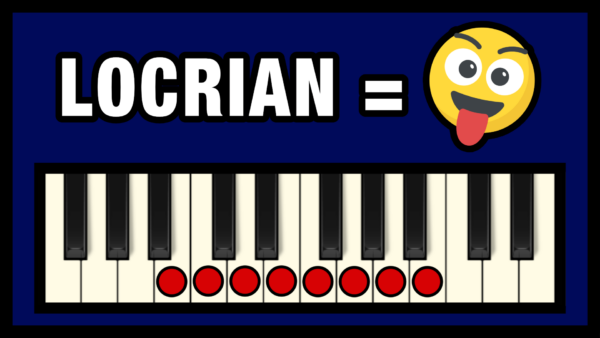 You are now going to learn the Locrian Mode of music. You will get a quick reference guide, plus a free chord chart of the Locrian Mode.
You are now going to learn the Locrian Mode of music. You will get a quick reference guide, plus a free chord chart of the Locrian Mode.
The Locrian Mode is what I personally call “the crazy mode”, because of the unstable overall sound. This is due to the flat 5th, which creates a diminished tonic chord. It is the only mode that lacks the stable harmonic relationship between the root note and the perfect 5th.
This flat 5th is what makes Locrian sound so twisted, and it lacks the ability to resolve with a true cadence. Therefore this mode is very uncommon to use for a whole composition, but it is more often used at certain points in a composition for that “dark and crazy” sound.
When I say the Locrian mode is Dark & Crazy”, you can think of “The Joker” in the Batman and Dark Knight movie franchise.
You can play this mode by starting on B, and then play all white keys up to the B an octave above it. Now let’s have a look at a quick overview guide of the Locrian Mode.
The Locrian Mode – Quick Guide
- Mode Feeling: Dark, Crazy, Unstable, Strange, Twisted
- Mode Pattern: R – h – W – W – h – W – W – W
- Mode Formula: 1 – b2 – b3 – 4 – b5 – b6 – b7

The Locrian Mode – Chord Chart
These are all diatonic triads of the Locrian Mode, plus the diatonic 7th chords in parenthesis.
- I = diminished (m7b5)
- II = Major (Maj 7)
- III = minor (min 7)
- IV = minor (min 7)
- V = Major (Maj 7)
- VI = Major (Dom 7)
- VII = minor (min 7)
Quick Guides on All 7 Modes
- Lydian Mode – Chord Chart and Quick Guide
- Ionian Mode – Chord Chart and Quick Guide
- Mixolydian Mode – Chord Chart and Quick Guide
- Dorian Mode – Chord Chart and Quick Guide
- Aeolian Mode – Chord Chart and Quick Guide
- Phrygian Mode – Chord Chart and Quick Guide
- Locrian Mode – Chord Chart and Quick Guide
PS. Here’s a link to a free printable modes chord chart.

